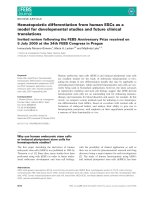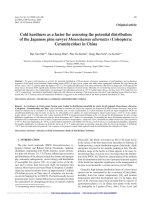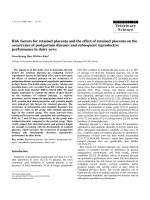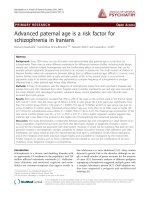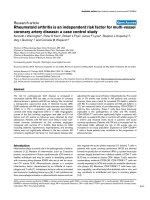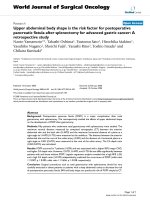Immigration as risk factor for non-suicidal self-injury and suicide attempts in adolescents in Germany
Bạn đang xem bản rút gọn của tài liệu. Xem và tải ngay bản đầy đủ của tài liệu tại đây (835.61 KB, 7 trang )
Plener et al. Child Adolesc Psychiatry Ment Health (2015) 9:34
DOI 10.1186/s13034-015-0065-4
Open Access
RESEARCH ARTICLE
Immigration as risk factor
for non‑suicidal self‑injury and suicide
attempts in adolescents in Germany
Paul L Plener1*, Lara M Munz1, Marc Allroggen1, Nestor D Kapusta2, Jörg M Fegert1 and Rebecca C Groschwitz1
Abstract
Background: Whereas non-suicidal self-injury (NSSI) and suicide attempts (SA) are rather common among adolescents, the description of risk factors has often failed to take migration into perspective. Our study aimed to describe
immigration status in adolescents with regards to their lifetime history of NSSI and SA.
Methods: We carried out a population based study in a school community of ninth-graders (N = 452, mean age
14.85, SD 0.58) in southern Germany. Data were collected via adolescent self report on sociodemographic variables
and on NSSI and SA using the Self Harm Behavior Questionnaire.
Results: Adolescents born outside Germany showed an elevated rate of a lifetime history of NSSI and SA. When compared to German adolescents without a (family) history of migration (NSSI 19.16%, SA 3.24%), adolescents who were
born in another country had an elevated risk for NSSI (42.86%, OR 3.36) and SA (17.86%, OR 6.78), which was higher
than the risk of adolescents who had at least one parent who had emigrated from another country (NSSI 30.08%, OR
2.46 and SA 8.94%, OR 4.45).
Conclusion: Our findings should inform intervention services and prevention programs for NSSI and suicidality in
youth. Adopting such programs to include culturally sensible modules could improve the outcome in ethnically
diverse adolescents.
Keywords: Non-suicidal self-injury, NSSI, Suicide attempts, Adolescents, Immigration, Migration
Background
Both non-suicidal self-injury (NSSI) and suicide
attempts are rather common among German adolescents. Whereas worldwide lifetime prevalence rates of
NSSI between 17 and 18% were reported from systematic reviews [1, 2], studies from Germany reported a
lifetime prevalence rate of 25.6% in adolescents [3], and
a 6-month prevalence rate of 14.6% [4]. Using criteria
proposed in section 3 of the DSM-5 for NSSI disorder
[5], a retrospective data analysis described a prevalence
of 4% among German adolescents [6]. Recently, a large
study comparing adolescent samples from 11 European
countries (including Israel) reported a lifetime prevalence
*Correspondence: paul.plener@uniklinik‑ulm.de
1
Department of Child and Adolescent Psychiatry and Psychotherapy,
University of Ulm, Steinhoevelstr. 5, 89075 Ulm, Germany
Full list of author information is available at the end of the article
rate of 27.6% of “direct self-injurious behavior” (D-SIB:
combining self-harming behaviors regardless of suicidal
intent). Adolescents from Germany showed the second
highest prevalence rate for occasional (22.9%) and for
repetitive (12.3%) D-SIB [7].
With regards to suicidal ideation and suicide attempts,
a large (n = 45,806) European study reported a median
lifetime prevalence rate of 10.5% for suicide attempts in
adolescents, with 30.8% reporting a history of self-harm
thoughts [8]. In Germany, lifetime prevalence rates of suicidal ideation in adolescents were reported to be between
14.5% [9], 36.4% [3] and 39.4% [10], with a reported
6-month prevalence rate of 3.8% [11]. A lifetime history
of suicide attempts was reported to be between 6.5% [3],
7.8% [9] and 9.0% [10].
Searching for predictors of NSSI, a recent systematic
review of longitudinal studies described several factors,
© 2015 Plener et al. This article is distributed under the terms of the Creative Commons Attribution 4.0 International License
( which permits unrestricted use, distribution, and reproduction in any medium,
provided you give appropriate credit to the original author(s) and the source, provide a link to the Creative Commons license,
and indicate if changes were made. The Creative Commons Public Domain Dedication waiver ( />publicdomain/zero/1.0/) applies to the data made available in this article, unless otherwise stated.
Plener et al. Child Adolesc Psychiatry Ment Health (2015) 9:34
stemming from 32 longitudinal studies [12]. Among
them were female gender, a history of previous NSSI, suicide attempts or suicidal ideation, and depressive symptoms. However, migration was not described being a risk
factor for NSSI in these studies, due to the fact that it
had not been included as a possible risk factor in most
studies. However, migration in itself might be viewed as
a combination of several stressors, for example the loss
of cultural connectedness, the use of another language,
the adaption to new norms and lifestyles, discrimination,
peer alienation and changes in the socioeconomic status
(for review [13]).
Literature about migration and suicidality in adolescents is still very scarce [13]. Furthermore, most studies
attempting to further explore migration status as risk
factor for NSSI and suicidal behavior have been conducted in the US. Borges et al. [14] reported from two
nationally representative surveys about suicidal behavior
being higher for Mexican immigrants who came to the
US before the age of 12, as well as for US born Mexican
Americans. Furthermore, the risk for suicide attempts
nearly doubled (OR 1.97) for US born Mexican Americans. Interestingly, in a study on Boston youth, Borges
et al. [15] described adolescents with a migration background not to be at higher risk for NSSI and suicidal
ideation than US born youth. However, being discriminated due to one’s ancestry increased the risk of NSSI
(OR 3.1) and suicidal ideation (OR 2.1) in US born youth
with a background of migration. The authors of the study
argued, that a dissonance between being born in a country and yet not being perceived as fully integrated could
create a distress in these youths [15]. In addition, it was
shown that US-born Latino adolescents were 2.87 times
more likely to attempt suicide as Latino youth born in
another country (i.e. first-generation youth). Third generation Latino youth (with US born parents) were even
3.57 times more likely to attempt suicide than first generation Latino adolescents [16]. Contrary to these findings,
differences in rates of suicide attempts between different ethnic groups in a large (N = 15,180) US based Collaborative Psychiatric Epidemiological survey vanished
to exist after adjusting for psychiatric disorders [17]. A
Canadian study looking into suicides in youth between
the age of 15 and 24, showed that immigrants´ suicide
death rate was lower than the death rate of Canadian
youth [18].
A European perspective has been reported based on
data from the WHO/EURO Multicentre Study on Suicidal Behaviour, in which suicide attempt rates of adults
were compared among 25 European centers. Overall,
suicide attempt rates were higher in participants with a
migration background when compared to the population of their host country. There was a strong correlation
Page 2 of 7
between suicide attempt rates among immigrants and
suicide rates in their countries of origin (with the exception of Chileans, Turks, Ukrainians and Iranians) [19].
In a large Swedish study of 10,018 young adults
between the ages of 18 and 29, non-European females
with a migration background showed a higher rate of
suicide attempts than their Swedish counterparts, which
was especially pronounced in first generation non-European females (OR 3.52) in comparison to second-generation females with a migration background (OR 1.60) [20].
In another Swedish study of more than a million children,
who were followed up prospectively, youth with both
parents being born outside of Sweden showed higher
rates of self-harm. However, these differences diminished
after adjusting for socioeconomic status, but were still
elevated in migrants from Finland, Western countries
and children of mixed couples (one parent from Sweden,
one from another country [21]). In a case–control study
comparing 70 Turkish immigrants, who had attempted
suicide and 70 Swiss suicide attempters, it could be
shown, that the percentage of young (between the age
of 15 and 25 years) Turkish women was higher than in
the Swiss comparison group [22]. In addition it has been
shown from a retrospective chart review of 210 children
and adolescents (6–18 years of age) presenting after a
suicide attempt to an Emergency Outpatient Clinic in
Istanbul, that besides immigration to a foreign country,
internal migration (migration from other parts of the
same country with large cultural differences) also serves
as a risk factor to choose a high risk method of suicide
attempt [23]. High acculturation stress, along with immigration stress was also reported to be associated with a
higher rate of self harming behaviors in a sample of 1,651
Hispanic adolescents [24].
Data about the association between NSSI, suicide
attempts and migration background is scarcely available from adolescent samples in Germany. However,
young adult women with a migration background have
been shown to have elevated rates of suicide and suicide attempts [25]. A study on suicide attempts of adult
women with Turkish origin in the Berlin region found
high age-adjusted incidence rates of suicide attempts
between 66.9 and 92.2/100,000, with highest rates in the
age group from 18 to 24 [26]. One large, representative
study of 44,610 adolescents showed immigration background to be a risk factor for suicide attempts, especially
for adolescents from “Islamic imprinted countries” (being
defined as “all countries whose culture is essentially influenced by Islamic theology” according to [10]) with an OR
of 1.55 [10]. In a recent study following a cohort of 6,378
German repatriates from Russia for up to 20 years, it has
been shown, that migration between the age of 11 and 20
increased the risk of committing suicide or dying from
Plener et al. Child Adolesc Psychiatry Ment Health (2015) 9:34
events of undetermined intent in males [27]. However,
NSSI has not been assessed in these studies. Overall,
migration can be viewed as under-researched risk factor
for self-harming behaviors. Our aim was to specifically
explore migration status as risk factor both for NSSI as
well as suicide attempts. We adjusted for socioeconomic
status, gender and age.
Methods
The survey was conducted as part of a study focusing
on motives and (especially social) risk factors for NSSI
and suicidal behavior in adolescents [28]. Students were
recruited from 9th grades of 10 schools (different types of
schooling: vocational, intermediate and academic) by giving oral and written information in the classroom within a
time period of 6 months. We chose ninth graders as in the
German school system different types of schooling branch
after ninth grade (some type of schooling ends after these
grade, whereas others go on for 10 or 12 grades). Written
information was provided for caregivers as both active
parental written informed consent as well as active adolescents’ written assent was necessary for participation
in the study. Participation in the study required a basic
knowledge of German language, as questionnaires were
only available in German. Of 748 eligible students in these
classes, 656 were present at the day of assessment and 452
(68.9%) of the students and their caregivers consented to
take part in the study. Due to German school regulations,
no data were obtained from those not participating in the
study. Of the 452 participating students (mean age 14.85,
SD 0.58; age range 14–17), 209 (46.2%) were female. With
regards to type of schooling, 15.9% visited a vocational
school (“Hauptschule”), 45.6% a school with intermediate
academic level (“Realschule”) and 38.5% a school with the
highest academic level (“Gymnasium”).
Assessment was anonymous as it is expected that
non-anonymous studies create a bias toward lower rates
of NSSI [2] because of study participants fearing consequences of disclosure of suicidality or NSSI. Participants with NSSI or suicidal behavior could contact the
study team using “contact cards” and ask them for help.
Furthermore, information cards were administered listing contact details of regional mental health providers
and counselling services. The study was approved by the
Institutional Review Board of the University of Ulm and
by the local school authorities.
Measures
Demographic measure
The questionnaire assessed gender, age, occupation of
parents and migration status. We assigned social class
retrospectively by calculating a standard household
income based on the students information about their
Page 3 of 7
parents occupation. Income approximations were based
on data from the German federal statistics bureau.
Migration status was assessed using three items asking
for country of birth of students, their parents and the
language spoken at home. Participants were defined as
“born in another country” if their country of birth was
not Germany. NSSI and suicide attempts were assessed
using a German version of the Self Harm Behavior Questionnaire (SHBQ) [3, 29]. The SHBQ is a self-report
measure with four subscales evaluating NSSI (‘Have you
ever hurt yourself on purpose?’), suicidal ideation (‘Have
you ever talked or thought about committing suicide?’),
and attempted suicide (‘Have you ever attempted suicide?’), as well as suicide threats (‘Have you ever threatened to commit suicide?’). The instrument has been
validated showing good internal consistency (Cronbach´s
α between 0.89 and 0.96 for 4 subscales) and has been
used in both American and German adolescent community samples [3, 30].
Statistical analysis
For group comparisons, Chi square test was applied.
Spearman correlation coefficients were calculated to
examine associations between suicide attempts and NSSI
with sociodemographic factors. Odds ratios for risk factors were based on logistic regression using SPSS version
21.0.
Results were only calculated for the subgroups “participant born in Germany” vs. “participant born in another
country” as well as “both parents born in Germany” vs.
“one or both parents born in another country”, as all other
subgroups (i.e. divided by country of origin or gender of
participants/parents) were too small for analyses. Results
of those small sub-groups are descriptively presented in
Table 1.
Results
Out of all participants, 28 (6.2%) were not born in Germany. Five adolescents were born in Russia and former Soviet Union countries and three in Turkey. Of the
students´ parents, 104 fathers (33%) and 101 mothers
(32.3%) were born in another country. In detail, 10 mothers and 10 fathers were born in Russia and former Soviet
Union countries and 33 mothers and 35 fathers in Turkey
(see Table 1).
In total, 92 (20.4%) of the adolescents reported a lifetime history of NSSI, and 18 (4%) of a suicide attempt.
Whereas girls reported NSSI more frequently (f: 61, m:
31; Chi2 = 18,926 df = 1, p < 0.001) no statistical significant gender difference was found for a history of suicide
attempts (f: 11, m: 7; Chi2 = 1,667 df = 1, p = 0.197).
Methods of suicide attempts included: ingestion of less
than 10 tablets (1), ingestion of more than 10 tablets
Plener et al. Child Adolesc Psychiatry Ment Health (2015) 9:34
Page 4 of 7
Table 1 Sociodemographic data of participants in relation to lifetime suicide attempts and NSSI
Total
Suicide attempt
NSSI
18 (4.0%)
92 (20.4%)
7 (3.04%)/11 (5.56%)
31 (12.97%)/61 (29.76%)
Total
452 (100%)
Age [M (SD)]
14.85 (0.58)
Gender (m/f )
243 (53.8%)/209 (46.2%)
Participants
Born in Germany
424 (93.8%)
13 (3.24%)
80 (19.16%)
Born outside of Germany
28 (6.2%)
5 (17.86%)
12 (42.86%)
Born in Turkey
3 (0.7%)
2 (66.67%)
2 (66.67%)
Born in Russia (or former USSR)
5 (1.1%)
1 (20.00%)
3 (60.00%)
20 (4.4%)
2 (10.00%)
7 (36.84%)
Both parents born in Germany
Born in another foreign country
329 (72.79%)
7 (2.13%)
55 (16.72%)
At least one parent born outside of Germany
123 (27.21%)
11 (8.94%)
37 (30.08%)
Fathers
Born in Germany
348 (77.0%)
13 (3.95%)
64 (18.71%)
Born outside of Germany
104 (33%)
5 (4.81%)
28 (26.92%)
Born in Turkey
35 (7.7%)
3 (9.38%)
12 (35.29%)
Born in Russia (or former USSR)
10 (2.2%)
1 (10.00%)
3 (30.00%)
Born in another foreign country
59 (13.1%)
1 (1.75%)
13 (22.41%)
Mothers
Born in Germany
351 (77.7%)
9 (2.71%)
64 (18.55%)
Born outside of Germany
101 (32.3%)
9 (8.91%)
28 (27.72%)
Born in Turkey
33 (7.3%)
3 (10.00%)
10 (31.52%)
Born in Russia (or former USSR)
10 (2.2%)
1 (10.00%)
3 (20.00%)
Born in another foreign country
58 (12.8%)
5 (8.77%)
15 (26.31%)
(2), ingestion of two or more substances (1), direct bodily harm (8), asphyxiation, hanging or use of a weapon
(3). Most of the adolescents with a history of a suicide
attempt reported one attempt (46.67%), with less reporting two (33.22%), three (6.67%) or more than three
(13.33%) attempts. The majority of attempts have been
carried out within 1 year prior to the study (57.14%),
7.14% between 1 and 2 years before the study and 35.71%
more than 2 years ago.
Adolescents, who were born outside of Germany
reported a higher life time prevalence of NSSI and suicide attempts (see Fig. 1). These differences were statistically significant for NSSI (Chi2 = 9.796 df = 1, p = .002)
and for suicide attempts (Chi2 = 14.654 df = 1, p < .001).
Adolescents born outside of Germany only reported
ingestion of more than 10 tablets (2) and direct bodily
harm (3) as suicide attempt methods.
NSSI was initiated by 44 adolescents (47.83%) within
the last year, by 40 (46.74%) 2 to 3 years ago, five (5.43%)
had started 4 to 5 years ago and 2 (1.09%) 6 years or
longer ago. For most of the adolescents reporting a history of NSSI the latest incident of NSSI had occurred
within the last year prior to the study (60, 65.2%; 12.03%
of adolescents born in Germany vs. 32.14% of the adolescents born outside of Germany). Of those adolescents
50.%
40.%
30.%
20.%
10.%
0.%
NSSI
Born in Germany (N=424)
Suicide aƩempt
Born in different country (N=28)
Fig. 1 Lifetime prevalence of NSSI and suicide attempts in adolescents being born in Germany in comparison to those being born
outside of Germany.
reporting NSSI 42 (45.65%) reported a single incident,
19 (20.65%) had hurt themselves twice, 10 (10.87%) three
times an 21 (22.83%) four times or more.
We found a positive association between suicide
attempts and being born outside of Germany as well as
a positive correlation between suicide attempts and having at least one parent who was not born in Germany (see
Table 2).
Gender was not associated with migration background
(r = .013, p = .788 for being born outside of Germany
and r = −.061, p = .195 for at least one parent being born
Plener et al. Child Adolesc Psychiatry Ment Health (2015) 9:34
Page 5 of 7
Table 2 Correlation of lifetime history of suicide attempts
and NSSI with socio-demographic data focusing on migration
Age
Gender
Family income
Participant born in another
country
Suicide attempt
NSSI
r
r
p
.08
.09
−.06
.20
−.07
.18
p
.08
−.08
.21**
<.001
.04
.47
.19**
<.001
.15**
<.002
One or both parents born
in another country
.16**
<.001
.15**
<.002
Language at home other
than German
.11
.03
−.11
.02
−.03
.61
.01
.81
Language with friends
other than German
Bonferroni-corrected: significance level at p < .005.
outside of Germany) and was therefore not included in
the regression analyses as a possible predictor.
In a logistic regression analysis, both being born outside of Germany and having at least one parent who was
born in another country explained 10% of the variance
(see Table 3).
NSSI showed a positive association with being born
outside of Germany, and having at least one parent who
was born in another country. However, being born outside of Germany was not significant in the regression
analysis and was therefore dropped from the model. Having at least one parent who was born in another country
explained 4.5% of the variance. (see Table 3).
Compared to adolescents with no background of
migration, those who were born outside of Germany had
an elevated risk for NSSI (OR 3.36) and suicide attempts
(OR 6.78). Those adolescents who had at least one parent
who was born in another country also had higher risks
for NSSI (OR 2.46) and suicide attempts (OR 4.45) compared to those whose parents were born in Germany.
Discussion
We assessed a sample of 9th grade students from a community population in Germany with regards to NSSI and
suicide attempts. The lifetime prevalence rate of 20.4%
for NSSI seems comparable with former studies on NSSI
in Germany [3] and is in the range of NSSI prevalence in
adolescent community samples worldwide [1]. The rate of
suicide attempts (4%) is lower than in other recent studies on German school populations (e.g. [9, 10] ) but closer
to a previous study using the same assessment instrument [3], so that these differences might be explained by
assessment methodology. Whereas a clear gender difference existed for NSSI, no statistically significant gender
difference was found with regards to suicide attempts.
This is contrary to former studies of suicide attempts
in German minors [9] and is possibly attributable to
low numbers of suicide attempts in our study. Family
income was neither associated with NSSI, nor with suicide attempts. This may be due to the fact that economic
burden is less of a risk factor for suicidality in the minors,
than it is for adults, (e.g. in [31]), a finding that has been
reported in other studies as well [32].
We aimed to evaluate whether migration should be
understood as risk factor for NSSI or suicide attempts in
adolescents. In summary, our findings support the notion
that migration serves as a risk factor for both. We were able
to show that both, being born outside of Germany as well
as having one parent with migration background serves as
risk factor for NSSI and suicide attempts. This shows that
even in the second generation of migrants, these factors
seem to play a relevant role in influencing the risk for selfharming behaviors. The findings of elevated rates of suicide
attempts in adolescents with migration background is in
line with recent work from another German sample [10].
Adolescents of whom at least one parent was born outside of Germany had elevated odds of a lifetime history of
suicide attempts (OR 4.45), an effect, that was even more
pronounced in adolescents being born outside of Germany
(OR 6.78). This is in line with findings of elevated risk of
suicide attempts in females with non-European migration background in a large population based study from
Sweden [20]. However, these results were contradicting
findings from the US, reporting higher rates of suicide
attempts in second and third generation Latino youth [16].
These differences might be explained by the specific situation of Latino youth in the US, with the Swedish situation
Table 3 Logistic regression analyses with suicide attempts and NSSI as dependent variables
Coefficient
Standard error
Wald p value
1.14
.55
.038
.268
.025
Dependent variable: suicide attempt
Factor: one or both parents born in another country
.100
Dependent variable: NSSI
Factor: one or both parents born in another country
Nagelkerkes R-Square
.045
.601
Factors were drawn from correlation-analyses. Significance level at p < .05.
Plener et al. Child Adolesc Psychiatry Ment Health (2015) 9:34
being more comparable to the situation in Germany. The
finding of higher rates of NSSI and suicide attempts in
adolescents with a first generation migration background
could be due to possible traumatic events acquired
throughout the experience of cultural and social disruption when moving to another country. However, due to the
small numbers in our sample, differences between these
groups have to be interpreted with extreme caution.
As stressors are influential for the development of
NSSI (such as for example, in the integrated theoretical model of NSSI by Nock [33]), increasing stress can
lead to higher levels of NSSI. With respect to suicidality,
migration could contribute to a feeling of perceived burdensomeness (as in Germany some groups of immigrants
are not allowed to work for a certain time span, therefore
being reliant on social welfare) and thwarted belongingness (e.g. feeling isolated due to language or cultural barriers or cultural stress (see [23]). Both of these factors
contribute to an increased risk for suicide, based on the
interpersonal psychological theory of suicide by Joiner
[34]. Referring to these theoretical models, it seems reasonable to expect a higher risk for both NSSI and suicidality in adolescents with a background of immigration.
Several limitations do apply when interpreting our
findings. First, we used an anonymous self-report survey that was announced as a study of NSSI, suicidality
and social influences. As was shown by Swanell et al. [2],
both factors (anonymity and announcement as a study
of NSSI) could influence the rates of NSSI (and possibly
suicidality) towards a higher prevalence. However, as we
wanted to ensure the possibility to answer truly without having to fear possible consequences, we chose the
given procedure. Relying on self-report could create a
recall bias between groups. Second, the SHBQ does not
allow to further define suicide attempts by chronicity or
severity, so that there might be the possibility that differences in suicidality between groups might have not
been detected. Third, as both the consent and assent
forms as well as the information sheets and the questionnaires were only available in German, this might have
created a bias towards non-participation of adolescents
with language barriers, or of adolescents whose parents
were not able to understand the provided information.
Fourth, due to school authority regulations we were not
able to collect data from non-participants, therefore not
being able to provide an analysis of adolescents, who (or
their parents) chose not to participate in this study. Fifth,
in our study, migration was only measured in terms of
country of origin (both of the participants and their parents) and language spoken at home. We did not assess
subjective feelings of discrimination due to migration
status, which could have been useful to further analyze
the ongoing psychological mechanisms in more detail.
Page 6 of 7
Sixth, variance explained by the main factors being born
in another country, and at least one parent being born in
another country, was quite low. This is probably due to
the vast number of possible predictors of NSSI and suicide attempts which have been found in other studies (i.e.
psychiatric symptoms, social support, adverse life-events,
etc.) and have not been assessed in this study. Furthermore, the factors age at immigration, number of moves,
move distance, duration of immigration status, degree of
depression and somatization of adolescents and parents,
actual or former medication or psychotherapeutic interventions or inpatient therapies were not assessed. These
factors might have influenced the rates of NSSI and suicidality for some of the participants. Results of this study
therefore only focus on a small aspect of possible predictors of NSSI and suicidality. However, due to high oddsratios found in this study, results still seem to be relevant
to research and prevention of NSSI and suicidality. Seventh, the sample of immigrants is not representative of
the total German foreign born population.
To our knowledge, this is the first study analyzing
migration background with regards to NSSI and suicide
attempts in adolescents living in Germany. Our findings
seem—at least in part—comparable to other studies in
youth who experienced immigration in the first or second generation in Europe. It is unclear, whether these
higher rates of suicide attempts will lead to a higher rate
of committed suicides in later years, but evidence from a
large sample of German repatriates from Russia suggests,
that this could be the case as higher rates in males, who
immigrated between the ages of 11 and 20 were reported
[27]. The median lag time between migration and suicide was 8 years [27], so that there seems to be a need for
prevention campaigns especially addressing adolescents
or young adults with a history of immigration. Showing
the scope of the problem, it seems necessary to include
a culturally informed migration perspective in NSSI and
suicidality prevention programs tailored for adolescents
and young adults. With regards to intervention in suicidal crises, a program targeting Turkish women (with
the use of telephone hotlines or training of lay persons)
from Germany seemed promising [23]. However, so far
these intervention procedures have only been applied
in certain regions, mostly targeting adults. Our findings
underscore the need for widening tailored approaches for
adolescents with migration background in Germany.
Authors’ contributions
PLP designed and carried out the study, and drafted the manuscript. LMM
undertook the literature research, analyzed and summarized the studies. MA
assisted with the literature review and drafting the manuscript. NDK helped
with the interpretation of data and added further literature. JMF was involved
in designing the study and drafting the manuscript. RCG was involved in
analyzing the data and helped to draft the manuscript. All authors read and
approved the final manuscript.
Plener et al. Child Adolesc Psychiatry Ment Health (2015) 9:34
Author details
1
Department of Child and Adolescent Psychiatry and Psychotherapy, University of Ulm, Steinhoevelstr. 5, 89075 Ulm, Germany. 2 Department of Psychoanalysis and Psychotherapy, Medical University of Vienna, Vienna, Austria.
Acknowledgements
This analysis was initiated by a request of the scientific advisory board on
family affairs of the German Ministry of Family Affairs. Prof. Fegert is the vice
president of this board.
Compliance with ethical guidelines
Competing interests
PLP declares no competing interests. In the last 5 years he was a PI in a study
for Lundbeck. He received research grants from the BMBF (German Ministries
for Research and Education) and the BfArM (German Federal Institute for
Drugs and Medical devices). He received travel grants from the DFG, DAAD
and IACAPAP. He isn’t stockholder or share-holder in the pharmaceutical
industry. JMF received during the last 5 years: Research funding from EU, DFG,
BMG, BMBF, BMFSFJ, several state ministries of social affairs, State Foundation
Baden-Württemberg, Volkswagen Foundation, European Academy, Pontifical
Gregorian University, RAZ, CJD, Caritas, Diocese of Rottenburg-Stuttgart; Travel
grants, honoraria and sponsoring for conferences and medical educational
purposes from DFG, AACAP, NIMH/NIH, EU, Pro Helvetia, Janssen-Cilag (J&J),
Shire, several universities, professional associations, and German federal and
state ministries. JMF is not part of any “speakers bureau”. He conducted clinical
trials for Janssen-Cilag, Lundbeck, BMBF, Servier, was on the steering committees and DSMB for Lundbeck, Servier. He holds no stocks, no interests in
pharmaceutical companies and is the majority owner of the 3Li institute. LMM,
MA, NDK and RCG declare that they have no competing interests.
Received: 15 April 2015 Accepted: 24 June 2015
References
1. Muehlenkamp JJ, Claes L, Havertape L, Plener PL (2012) International
prevalence of adolescent non-suicidal self-injury and deliberate self
harm. Child Adolesc Psychiatry Ment Health 6:10
2. Swannell S, Martin GE, Page A, Hasking P, St John NJ (2014) Prevalence of
nonsuicidal self-injury in nonclinical samples: systematic review, metaanalysis and meta-regression. Suicide Life Threat Behav 44:273–303
3. Plener PL, Libal G, Keller F, Fegert JM, Muehlenkamp JJ (2009) An international comparison of adolescent non-suicidal self-injury (NSSI) and
suicide attempts: Germany and the USA. Psychol Med 39:1549–1558
4. Plener PL, Fischer CJ, In-Albon T, Rollett B, Nixon MK, Groschwitz RC et al
(2013) Adolescent non-suicidal self-injury (NSSI) in German-speaking
countries: comparing prevalence rates from three community samples.
Social Psychiatry Psychiatr Epidemiol 48:1439–1445
5. American Psychiatric Association (2013) Diagnostic and statistical manual
of mental disorders, 5th edn. American Psychiatric Association, Arlington
6. Plener PL, Kapusta ND, Kölch MG, Kaess M, Brunner R (2012) Nichtsuizidale Selbstverletzung als eigenständige Diagnose. Implikationen
des DSM-5 Vorschlages für Forschung und Klinik selbstverletzenden
Verhaltens bei Jugendlichen. Zeitschrift für Kinder- und Jugendpsychiatrie und Psychotherapie 40:113–120
7. Brunner R, Kaess M, Parzer P, Fischer G, Carli V, Hoven CW et al (2014)
Life-time prevalence and psychosocial correlates of adolescent direct
self-injurious behavior: a comparative study of findings in 11 European
countries. J Child Psychol Psychiatry 55:337–348
8. Kokkevi A, Rotsika V, Arapaki A, Richardson C (2012) Adolescents’ selfreported suicide attempts, self-harm thoughts and their correlates across
17 European countries. J Child Psychol Psychiatry 53:381–389
9. Kaess M, Parzer P, Haffner J, Steen R, Roos J, Klett M et al (2011) Explaining
gender differences in non-fatal suicidal behavior among adolescents: a
population-based study. BMC Public Health 11:597
10. Donath C, Graessel E, Baier D, Bleich S, Hillemacher T (2014) Is parenting
style a predictor of suicide attempts in a representative sample of adolescents? BMC Pediatr 14:113
Page 7 of 7
11. Ravens-Sieberer U, Wille N, Erhardt M, Bettge S, Wittchen HU, Rothenberger A et al (2008) Prevalence of mental health problems among
children and adolescents in Germany: results of the BELLA study within
the National Health Interview and Examination Survey. Eur Child Adolesc
Psychiatry 17:22–33
12. Plener PL, Schuhmacher T, Munz LM, Groschwitz RC (2015) The longitudinal course of non-suicidal self-injury and deliberate self-harm: searching
for predictors. A systematic review of the literature. Borderline Personal
Disord Emot Dysregul 2:2
13. Bursztein Lipsicas C, Mäkinen IH (2010) Immigration and suicidality in the
young. Can J Psychiatry 55:5
14. Borges G, Breslau J, Su M, Miller M, Medina-Mora ME, Aguilar-Gaxiola S
(2009) Immigration and suicidal behavior among Mexicans and Mexican
Americans. Am J Public Health 99:4
15. Borges G, Azrael D, Almeida J, Johnson RM, Molnar BE, Hemeway D et al
(2011) Immigration, suicidal ideation and deliberate self-injury in the
Boston youth survey 2006. Suicide Life Threat Behav 41:193–202
16. Pena JB, Wyman PA, Brow CH, Matthieu MM, Olivares TE, Hartel D et al
(2008) Immigration generation status and its association with suicide
attempts, substance use, and depressive symptoms among latino adolescents in the USA. Prev Sci 9:299–310
17. Borges G, Orozco R, Rafful C, Miller E, Breslau J (2012) Suicidality, ethnicity
and immigration in the USA. Psychol Med 42:1175–1184
18. Malenfant EC (2004) Suicide in Canada’s immigrant population. Health Rep
15:2
19. Bursztein Lipsicas C, Mäkinen IH, Apter A, De Leo D, Kerkhof A, Lönnqvist J, Michel K et al (2012) Attempted suicide among immigrants in
European countries: an international perspective. Soc Psychiatry Psychiatr
Epidemiol 47:241–251
20. Kosidou K, Hellner-Gumpert C, Fredlund P, Dalman C, Hallqvist J, Isacsson
G (2012) Immigration, Transition into Adult Life and Social Adversity in
Relation to Psychological Distress and Suicide Attempts among Young
Adults. PLoS One 7:10
21. Jablonska B, Lindber L, Lindblad F, Hjern A (2009) Ethnicity, socio-economic status and self-harm in Swedish youth: a national cohort study.
Psychol Med 39:87–94
22. Tarik Yilmaz A, Riecher-Rössler A (2012) Attempted suicide in immigrants
from Turkey: a comparison with Swiss suicide attempters. Psychopathology 45:366–373
23. Akkaya-Kalayci T, Popow C, Winkler D, Bingöl RH, Demir T, Özlü Z (2015)
The impact of migration and culture on suicide attempts of children and
adolescents living in Istanbul. Int J Psychiatry Clin Pract 19:32–39
24. Cervantes RC, Goldbach JT, Varela A, Santisteban DA (2014) Self-harm
among Hispanic adolescents: investigating the role of culture-related
stressors. J Adolesc Health 55:633–639
25. Schouler-Ocak M (2015) Suizidraten und Suizidprävention bei Berliner
Frauen mit türkischem Migrationshintergrund. Gesundheitswesen (in press)
26. Aichberger MC, Heredia Montesinos A, Bromand Z, Yesil R, TemurErman S, Rapp MA et al (2015) Suicide attempt rates and intervention
effects in women of Turkish origin in Berlin. Eur Psychiatry. doi:10.1016/j.
eurpsy.2014.12.003
27. Deckert A, Winkler V, Meisinger C, Heier M, Becher H (2015) Suicide and
external mortality pattern in a cohort of migrants from the former Soviet
Union to Germany. J Psychiatry Res 63:36–42
28. Young R, Sproeber N, Groschwitz RC, Preiss M, Plener PL (2014) Why Alternative teenagers self-harm: exploring the link between non-suicidal selfinjury, attempted suicide and adolescent identity. BMC Psychiatry 14:137
29. Gutierrez PM, Osman A, Barrios FX, Kopper BA (2001) Development and
initial validation of th Self-Harm Behavior Questionnaire. J Pers Assess
77(3):475–490
30. Muehlenkamp JJ, Cowles ML, Gutierrez PM (2010) Validity of the SelfHarm Behavior Questionnaire with diverse adolescents. J Psychopathol
Behav Assess 32:236–245
31. Taylor R, Page A, Morrell S, Carter G, Harrison J (2004) Socio-economic
differentials in mental disorders and suicide attempts in Australia. Br J
Psychiatry 185:486–493
32. Goodman E (1999) The role of socioeconomic status gradients in explaining differences in US adolescents’ health. Am J Public Health 89:1522–1528
33. Nock MK (2010) Self-injury. Ann Rev Clin Psychol 6:15.1–15.25
34. Joiner T (2005) Why people die by suicide. Harvard University Press,
Cambridge, London



